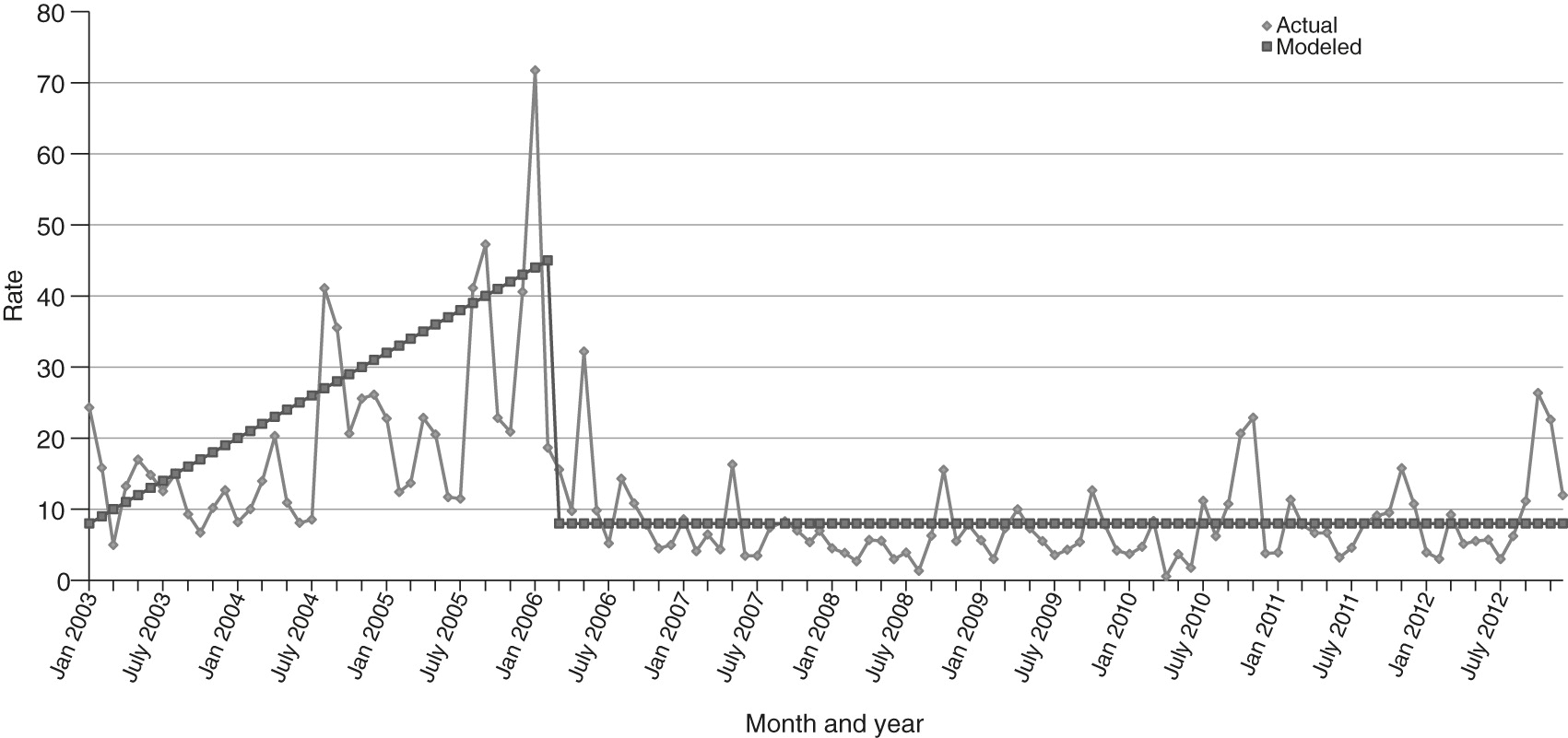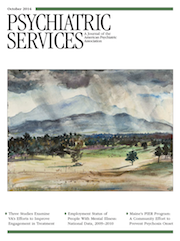There is a growing consensus that the use of institutional measures of control in psychiatric units and hospitals, such as seclusion and restraint, are common and potentially countertherapeutic—especially for vulnerable patients with prior exposure to traumatic events (
1–
3). Various health care organizations and patient advocacy groups have called for care that is more “trauma informed” and less dependent on institutional measures of control. Drawing on recommendations of the National Association of State Mental Health Program Directors and others (
3,
4) and with encouragement from accrediting bodies such as the Joint Commission, several systems of care have made efforts to reduce the use of seclusion and restraint. These efforts generally yield significant reductions in use of seclusion and restraint after the intervention (
5). Although these data are promising, studies are largely descriptive, lack an experimental design, are unable to compare the effectiveness of the interventions used, and report limited follow-up data (
6–
10).
We previously described a plan that we undertook to reduce seclusion and restraint use (
11,
12). The plan involved implementing a multicomponent intervention that used a multiple-baseline, time-series design. The first component of the intervention consisted of an observation-only period, given the established relationship of administrative commitment and reduction in seclusion and restraint use. Subsequent, active components of the intervention included training related to trauma-informed care (for example, trauma’s effects on patients’ physiology and psychology), changes to rules and language (for example, making policies less restrictive), training related to patient involvement in treatment planning (for example, highlighting the clinical benefits of shared decision making), and changes to the therapeutic environment (for example, repainting walls with warm colors, using decorative rugs and plants, and replacing and restructuring furniture in common areas). The final component was part of a larger institutional effort and included a scripted introduction geared toward improving patient-staff communication. Of note, each hospital unit was assigned two separate periods in which to make changes to the therapeutic environment. The medical director led all trainings over dedicated, half-day seminars.
Each unit implemented all components of the intervention over time and each in a different and randomly selected order, allowing researchers to examine the unique effects of each component while controlling for competing explanations of time, order, and location. Major findings showed an 82.3% reduction in the rate of seclusion and restraint over a 3.5-year period. After we controlled for illness severity and nonspecific effects, changes to the physical environment were uniquely associated with a significant reduction in the rate of seclusion and restraint, whereas changes related to trauma-informed care training, unit rules and language, and involvement of patients in treatment planning did not uniquely contribute to outcomes. Ongoing improvements to the physical environment may have served as a reminder to staff of the institutional commitment to eliminating seclusion and restraint use (
13).
During the subsequent 4.5 years, limited administrative efforts were directed toward seclusion and restraint reduction, and a number of factors could have increased or decreased use. Training in trauma-informed practices was included as part of new staff orientation (trimmed in content and duration), but the medical director had limited involvement. No additional efforts were directed toward sustaining changes to unit rules or further involving patients in treatment planning. There were significant changes in administrative structure, with the departure of advocates of the original intervention, including the hospital’s administrator and medical director. Environmental changes were also made—for example, all 64 restrooms in the hospital were systematically remodeled from October 2009 to September 2012—that had the potential to negatively affect intervention gains. Regulatory changes also could have affected seclusion and restraint use.
This naturalistic, follow-up study examined archival data on rates of seclusion and restraint by using a longer preintervention baseline phase and examined the longer-term sustainability of intervention gains in the absence of a specific research agenda. Thus our analysis examined seclusion and restraint rates at a single institution over ten years (January 1, 2003, through December 31, 2012). These data are significant in that we could find no published data on the longer-term impact (sustainability) of interventions to reduce seclusion and restraint in psychiatric settings.
Methods
The study was conducted at an inpatient psychiatric facility that consisted of 95 beds across five units: adult high acuity, general adult, geriatric, child and adolescent, and substance abuse. The facility has a statewide catchment area and generally operates at capacity. This study employed a naturalistic, experimental design. During the extended two-year baseline period from January 2003 through December 2004, no systematic efforts were directed toward reduction in seclusion and restraint use. During the 3.5-year systematic study period from January 2005 through June 2008, the multiple-baseline design described above was implemented. The systematic study period consisted of a baseline phase from January 2005 through February 2006, an implementation phase from March 2006 through March 2008, and a limited follow-up period from April 2008 through June 2008. During the subsequent 4.5 years (through December 31, 2012) in the extended follow-up phase, no specific efforts were directed toward seclusion and restraint reduction.
The rate of seclusion and restraint was calculated as the number of seclusion or restraint incidents per 1,000 patient-days across all inpatient units. This information is routinely collected and tracked in accordance with the Joint Commission’s quality and safety standards and is maintained in internal databases at the study site. This study employed a simulation modeling approach (SMA) to test for changes in monthly seclusion and restraint rates over time. SMA is a variant of bootstrapping methodologies and utilizes four parameters of the observed data stream—the autocorrelation estimate from the identified time period (A), the autocorrelation from the compared time period (B), the number of observations in the identified time period (A), and the number of observations from the compared period (B)—to generate thousands of simulated data streams drawn randomly from a known null distribution of data streams, all of which have the same autocorrelation and number of observations as the original observed data stream. When these thousands of data sets are evaluated, the user can determine the likelihood of various effect sizes given the specified levels of autocorrelation and N (when no effects are actually present).
On the basis of 100,000 simulated data streams, the specific analysis tested with SMA was a linear trend upward beginning in January 2003 and continuing through the baseline phase of the intervention component (through February 2006; phase A) compared with a stabilization effect during implementation and a limited follow-up period of the intervention and continuing through the extended follow-up period (March 2006 through December 2012; phase B).
All data were collected with full approval from the academic medical center’s Institutional Review Board.
Results
During the ten-year study interval, a total of 3,040 seclusion and restraint incidents were documented across 254,491 patient-days. After adjustment for the overall autocorrelation of .579, SMA indicated that phase A (N=38 months; mean=20.10 seclusions or restraint incidents per 1,000 patient-days) exhibited a linear trend upward, while phase B (N=82 months; mean=7.90 seclusion or restraint incidents per 1,000 patient-days) exhibited a stabilization effect (r=.659, p<.001) (
Figure 1).
Discussion
Our original study showed that systematic efforts to reduce the use of institutional measures of control are effective. The analysis reported here suggests that substantial reduction in the use of seclusion and restraint is sustainable. More specifically, this follow-up study suggests that once a culture shift occurs, judicious use of seclusion and restraint can become the new normative practice—even without senior leaderships’ overt support and despite substantial, potentially disruptive environmental changes to the overall environment—for example, remodeling all hospital restrooms over a three-year period. These renovations required cordoning off unit space to minimize risk of injury. Having less space available would have increased the number of patients in common areas, and density of physical space has been found to be associated with increased use of seclusion and restraint (
14). In addition, there was unavoidable construction-related noise—an environmental stressor that has been shown to be associated with a decrease in helping behaviors and with an increase in aggressive behaviors (
15). Both of these circumstances could have increased the use of seclusion and restraint by negatively affecting staff and patient behavior, respectively.
As may have been the case with previous improvements to the physical environment that were uniquely associated with reductions in use of seclusion and restraint (
13), the restroom renovations may have continued to serve as a reminder to staff of a changed culture and ongoing institutional commitment to eliminating the use of potentially countertherapeutic measures of control. The findings of this study, however, suggest that there may be a limit to the benefits of environmental improvements, because no further reduction in seclusion and restraint use was noted. Although temporarily disruptive to the milieu, the renovated restrooms eventually may have increased the comfort level on the units, an architectural design feature that has been shown to be associated with a reduced need for seclusion and restraint (
14).
This study’s naturalistic design, however, precludes any definitive statements of causality, and the lack of a true experimental design does not allow for any inferences regarding the driving mechanisms of the observed, sustained reduction in seclusion and restraint use. Despite these limitations, the original intervention’s multiple-baseline design and the ability to control for the effects of time and order of implementation of the interventions as well as for institutional “placebo” effects were unique strengths of the original study that lend support to the initial and longer-term impact of the intervention on seclusion and restraint use. Future research should examine facets of environmental and design features that affect seclusion and restraint use.
Conclusions
This examination of a decade of data on the use of countertherapeutic, institutional measures of control of psychiatric inpatients highlights the ability to shift the culture of one institution and sustain progress in the face of substantive administrative changes.
Acknowledgments and disclosures
This research was partly supported by the Menninger Foundation and McNair Medical Institute. Dr. Madan and Dr. Frueh are McNair Scholars. The study sponsors were not involved in any aspect of the research activities and did not approve the specific protocol or manuscript.
Dr. McLeod-Bryant reports an equity share in Electronic Health Networks, Inc. The other authors report no competing interests.


